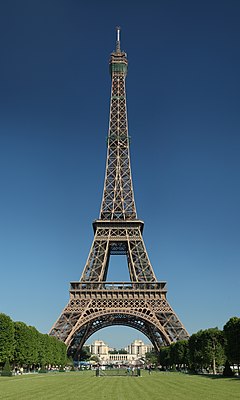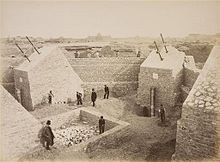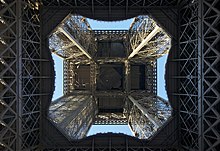Eiffel Tower

Seen from the Champ de Mars
| |
| Record height | |
|---|---|
| Tallest in the world from 1889 to 1930[I] | |
| General information | |
| Type | Observation tower Broadcasting tower |
| Location | 7th arrondissement, Paris, France |
| Coordinates | 48°51′29.6″N2°17′40.2″E |
| Construction started | 28 January 1887 |
| Completed | 15 March 1889 |
| Opening | 31 March 1889 (129 years ago) |
| Owner | City of Paris, France |
| Management | Société d'Exploitation de la Tour Eiffel (SETE) |
| Height | |
| Architectural | 300 m (984 ft)[1] |
| Tip | 324 m (1,063 ft)[1] |
| Top floor | 276 m (906 ft)[1] |
| Technical details | |
| Floor count | 3[2] |
| Lifts/elevators | 8[2] |
| Design and construction | |
| Architect | Stephen Sauvestre |
| Structural engineer | Maurice Koechlin Émile Nouguier |
| Main contractor | Compagnie des Etablissements Eiffel |
Construction
Work on the foundations started on 28 January 1887.[15] Those for the east and south legs were straightforward, with each leg resting on four 2 m (6.6 ft) concrete slabs, one for each of the principal girders of each leg. The west and north legs, being closer to the river Seine, were more complicated: each slab needed two pilesinstalled by using compressed-air caissons15 m (49 ft) long and 6 m (20 ft) in diameter driven to a depth of 22 m (72 ft)[16] to support the concrete slabs, which were 6 m (20 ft) thick. Each of these slabs supported a block of limestone with an inclined top to bear a supporting shoe for the ironwork.
Each shoe was anchored to the stonework by a pair of bolts 10 cm (4 in) in diameter and 7.5 m (25 ft) long. The foundations were completed on 30 June, and the erection of the ironwork began. The visible work on-site was complemented by the enormous amount of exacting preparatory work that took place behind the scenes: the drawing office produced 1,700 general drawings and 3,629 detailed drawings of the 18,038 different parts needed.[17] The task of drawing the components was complicated by the complex angles involved in the design and the degree of precision required: the position of rivet holes was specified to within 0.1 mm (0.0039 in) and angles worked out to one second of arc. The finished components, some already riveted together into sub-assemblies, arrived on horse-drawn carts from a factory in the nearby Parisian suburb of Levallois-Perret and were first bolted together, with the bolts being replaced with rivets as construction progressed. No drilling or shaping was done on site: if any part did not fit, it was sent back to the factory for alteration. In all, 18,038 pieces were joined together using 2.5 million rivets.[15]
At first the legs were constructed as cantilevers, but about halfway to the first level, construction was paused in order to create a substantial timber scaffold. This renewed concerns about the structural integrity of the tower, and sensational headlines such as "Eiffel Suicide!" and "Gustave Eiffel Has Gone Mad: He Has Been Confined in an Asylum" appeared in the tabloid press.[18] At this stage, a small "creeper" crane designed to move up the tower was installed in each leg. They made use of the guides for the lifts which were to be fitted in the four legs. The critical stage of joining the legs at the first level was completed by the end of March 1888.[15] Although the metalwork had been prepared with the utmost attention to detail, provision had been made to carry out small adjustments in order to precisely align the legs; hydraulic jacks were fitted to the shoes at the base of each leg, capable of exerting a force of 800 tonnes, and the legs were intentionally constructed at a slightly steeper angle than necessary, being supported by sandboxes on the scaffold. Although construction involved 300 on-site employees,[15] only one person died, due to Eiffel's safety precautions and the use of movable gangways, guardrails and screens.
Design
Material
The puddled iron (wrought iron) of the Eiffel Tower weighs 7,300 tons,[57] and the addition of lifts, shops and antennae have brought the total weight to approximately 10,100 tons.[58] As a demonstration of the economy of design, if the 7,300 tons of metal in the structure were melted down, it would fill the square base, 125 metres (410 ft) on each side, to a depth of only 6.25 cm (2.46 in) assuming the density of the metal to be 7.8 tons per cubic metre.[59] Additionally, a cubic box surrounding the tower (324 m x 125 m x 125 m) would contain 6,200 tons of air, weighing almost as much as the iron itself. Depending on the ambient temperature, the top of the tower may shift away from the sun by up to 18 cm (7 in) due to thermal expansion of the metal on the side facing the sun.[60]
Wind considerations
When it was built, many were shocked by the tower's daring form. Eiffel was accused of trying to create something artistic with no regard to the principles of engineering. However, Eiffel and his team – experienced bridge builders – understood the importance of wind forces, and knew that if they were going to build the tallest structure in the world, they had to be sure it could withstand them. In an interview with the newspaper Le Temps published on 14 February 1887, Eiffel said:
He used graphical methods to determine the strength of the tower and empirical evidence to account for the effects of wind, rather than a mathematical formula. Close examination of the tower reveals a basically exponential shape.[62] All parts of the tower were over-designed to ensure maximum resistance to wind forces. The top half was even assumed to have no gaps in the latticework.[63] In the years since it was completed, engineers have put forward various mathematical hypotheses in an attempt to explain the success of the design. The most recent, devised in 2004 after letters sent by Eiffel to the French Society of Civil Engineers in 1885 were translated into English, is described as a non-linear integral equation based on counteracting the wind pressure on any point of the tower with the tension between the construction elements at that point.[62]
The Eiffel Tower sways by up to 9 centimetres (3.5 in) in the wind.[64]
Accommodation
When originally built, the first level contained three restaurants—one French, one Russian and one Flemish—and an "Anglo-American Bar". After the exposition closed, the Flemish restaurant was converted to a 250-seat theatre. A promenade 2.6-metre (8 ft 6 in) wide ran around the outside of the first level. At the top, there were laboratories for various experiments, and a small apartment reserved for Gustave Eiffel to entertain guests, which is now open to the public, complete with period decorations and lifelike mannequins of Eiffel and some of his notable guests.[65]
In May 2016, an apartment was created on the first level to accommodate four competition winners during the UEFA Euro 2016 football tournament in Paris in June. The apartment has a kitchen, two bedrooms, a lounge, and views of Paris landmarks including the Seine, the Sacre Coeur, and the Arc de Triomphe.[66]
Passenger lifts
The arrangement of the lifts has been changed several times during the tower's history. Given the elasticity of the cables and the time taken to align the cars with the landings, each lift, in normal service, takes an average of 8 minutes and 50 seconds to do the round trip, spending an average of 1 minute and 15 seconds at each level. The average journey time between levels is 1 minute. The original hydraulic mechanism is on public display in a small museum at the base of the east and west legs. Because the mechanism requires frequent lubrication and maintenance, public access is often restricted. The rope mechanism of the north tower can be seen as visitors exit the lift.











No comments:
Post a Comment
Note: only a member of this blog may post a comment.